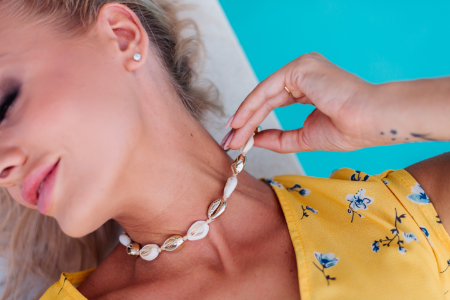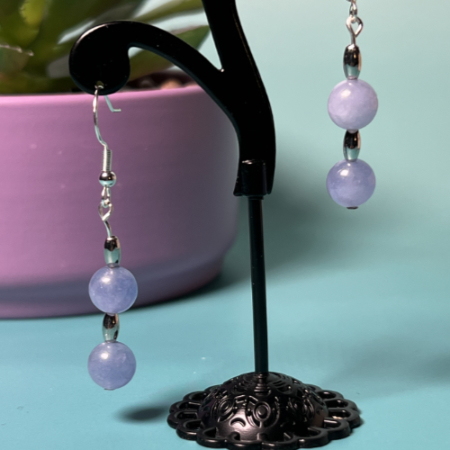
If there’s one thing we know about jewelry lovers, it’s that we’re always searching for pieces that tell a story. In 2025, the spotlight is shining brightly on handmade jewelry, where artistry meets sustainability in the most beautiful ways. Gone are the days of fast fashion accessories with no personality — this year, it’s all about meaningful, eco-friendly, and handcrafted designs that feel as good to wear as they look.
At Scott Jewelry Design, we’re thrilled about where the world of handmade jewelry is heading. Whether you’re a longtime collector or just dipping your toes into artisan-crafted accessories, here’s a look at the eco-chic and artisanal trends you’ll be seeing everywhere in 2025.
1. Sustainable Materials Take Center Stage
The demand for ethical fashion has made its way into the jewelry world in a big way. In 2025, handmade jewelry designers are embracing sustainable, recycled, and upcycled materials like never before. Think reclaimed metals, ethically sourced gemstones, ocean plastics transformed into beads, and repurposed vintage finds.
Not only do these materials reduce waste and environmental impact, but they also give each piece a unique history. Imagine wearing a necklace made from repurposed antique silver or earrings crafted from recycled glass — it’s style with a story, and we’re here for it.

2. Organic, Nature-Inspired Designs
This year, expect to see an abundance of jewelry inspired by the natural world. Artisans are taking cues from organic forms like leaves, shells, stones, and flowing water. Asymmetry and raw textures are in, giving pieces a wonderfully imperfect and earthy feel.
Hand-carved pendants, branch-like bangles, and earrings resembling tiny seashells will be adorning jewelry lovers everywhere. It’s a celebration of nature’s wild beauty, brought to life through the skilled hands of talented makers.

3. Bold, Sculptural Statements
While dainty jewelry has its timeless charm, 2025 is also ushering in a love for bold, sculptural pieces that command attention. Handmade artisans are creating wearable art that doubles as conversation starters — think oversized rings with abstract forms, chunky cuffs, and statement necklaces made from mixed media.
What makes this trend even better? These pieces are often crafted from upcycled or responsibly sourced materials, proving that you can go big and still stay green.
4. Personalized, Story-Driven Accessories
In 2025, jewelry is getting even more personal. Handmade jewelry offers the perfect canvas for custom designs that reflect the wearer’s story. From initial-stamped charms to birthstone-studded rings and meaningful symbol pendants, personalization is everywhere.
Artisans are also incorporating elements like engraved messages, vintage trinkets, and heirloom components into new designs. It’s all about creating keepsake-worthy jewelry with soul.

5. Minimalist with an Edge
For those who love clean, understated style, minimalist handmade jewelry is evolving with a bit of attitude. Think simple geometric shapes, but with hammered textures, matte finishes, or unexpected details like offset stones or asymmetrical lines.
This trend is perfect for layering — stack delicate rings with a slightly bold cuff or mix tiny studs with a single statement earring. It’s effortless, chic, and unmistakably modern.
6. Handcrafted Beading and Textile Elements
Hand-beaded jewelry is making a huge comeback, but with a contemporary twist. In 2025, artisans are blending traditional beading techniques with modern color palettes, sustainable threads, and even natural dyes. Look out for intricate beaded earrings, woven necklaces, and bracelets featuring eco-friendly fibers.
This revival of craft-based jewelry highlights the artistry behind every piece, reminding us of the time, skill, and heart that go into handmade work.
Why These Trends Matter
What makes these 2025 handmade jewelry trends so exciting is how beautifully they blend style with substance. In a world craving authenticity and conscious living, artisan jewelry offers a meaningful alternative to mass-produced accessories. Every piece is created by hand, often using sustainable practices and materials that honor the planet and its people.
At Scott Jewelry Design, we’re proud to be part of this movement. We believe in jewelry that not only looks stunning but also supports craftsmanship, ethical sourcing, and environmental responsibility.
Final Thoughts
As we move through 2025, expect to see more jewelry lovers gravitating toward pieces that feel personal, purposeful, and connected to the natural world. Whether you’re drawn to bold statement pieces or delicate, nature-inspired designs, there’s a handmade trend waiting for you to fall in love with.



Ready to explore the latest eco-chic and artisanal styles? Browse our collection at Scott Jewelry Design and discover jewelry that’s as unique and meaningful as you are.










